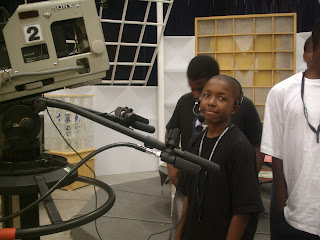Fifth annual Green Screen Youth Film Festival makes call for entries
September 21, 2011

DETROIT – Entries are currently being accepted for the upcoming fifth-annual Green Screen Youth Environmental Film Festival sponsored by East Michigan Environmental Action Council.
Green Screen provides a forum where students from across southeast Michigan and beyond showcase short films with environmental themes. These films allow young filmmakers to express what they think is most crucial to their health and to the natural environment. Some films also focus on making the world, their school or neighborhood environmentally healthier.
“We are really hoping that the entries feature a wide range of environmental and environmental justice issues pertinent to Southeast Michigan and will show a deepening involvement of youth in these critical issues,” said EMEAC Associate Director Lottie Spady who also directs the ReMedia Program. “We also are looking forward to food justice having a larger presence based on the work being done throughout the city around food.”
The festival is a celebration of youth voice and emerging environmentalism. The three-to-five-minute short films, created entirely by young artists and aspiring young activists, can span a range of environmental and social issues.
The films are judged for cinematic merit, relevance to Southeastern Michigan, and creative messaging. The panel of judges consists of independent directors, environmental activists, youth activists, and a journalists. Now in its fifth year, EMEAC gets statewide inquiries about this exciting event, as well as requests for film making workshops and demonstrations year round.
“This is the 5th year anniversary of EMEAC’s Green Screen. We are looking forward to celebrating this fact with a gala “Green Carpet” event,” said Spady who has guided the festival since its inception. “Each year the number of participants has increased, and with the collaborations we continue to build, this year will reflect even more meaningful relationships.
“We are kicking off with a Green Room where we invite young people city-wide to participate in a fun get-to-know-EMEAC pre-Green Screen event featuring the Tap Water Challenge, Recycle Relay, and Environmental Media Mash Up”
Once the event itself begins, young people will enjoy a unique opportunity to share their creative vision around how to address some of the more pressing environmental concerns of the day. Over the years, Spady says she has also been inspired by how youth voice can effectively reach adults.
“The goal is to showcase youth environmental media in such a way that guests begin to understand the importance, value, and relevancy of youth voice in the environmental justice and food justice movement. Also, they are moved to further support this work through skill sharing, mentoring, and monetary donations,” she said. “We’ve come so far in the creation of youth media that is highlighted at the Green Screen, yet we could do more to inform the ongoing conversation by developing youth leadership.
“Our next challenge is to move the event beyond a once a year showcase, to increase the visibility of this body of work for citizen’s education so young people see more people that look like them as experts on environmental issues. We’d like to see youth become peer educators on the topics of air quality, waste management, water access and affordability, and food justice.”
The date for this year’s Green Screen is November 17. Exact details regarding the location and time are still being worked out. In the meantime, organizers are hoping that community support from local businesses and organizations continues to grow each year.
“There are many way to support the efforts of Green Screen,” Spady said. “Please consider sponsoring a movie, sponsorship of the event, food donations, or just come out and attend. We hope to build our membership and longstanding relationships through this work.”
Deadline for entries is November 1st, 2011. Anyone interested entering a film for Green Screen 2011, sponsoring a film, volunteering or making a donation of support should call 313 559-7498 or visit www.emeac.org for Green Screen entry guidelines.




















